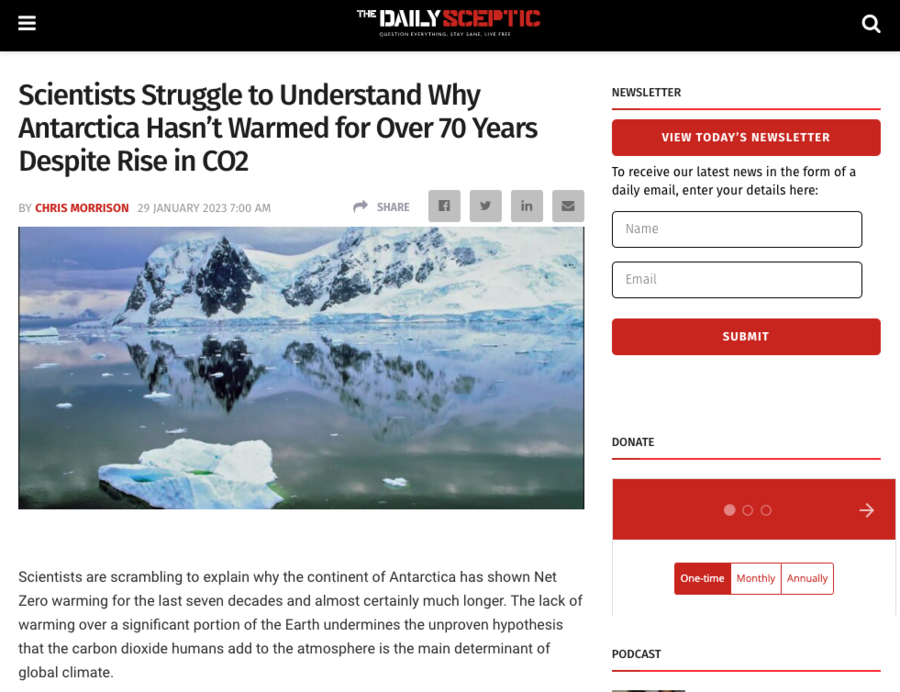
Have temperatures in Antarctica not increased in more than 70 years? No, that's not true: A climatologist and global climate expert told Lead Stories that it is "evident that temperatures are increasing across the Antarctic." According to official data, land surface temperatures in the region have increased an average of .16 degrees Fahrenheit (.09 degrees Celsius) per decade since 1950, for a total of a 5.4 degrees Fahrenheit (3 degrees Celsius) over that timeframe.
A version of the claim originated in an article published by The Daily Sceptic on January 29, 2023, titled, "Scientists Struggle to Understand Why Antarctica Hasn't Warmed for Over 70 Years Despite Rise in C02" (archived here). An introduction to the article read:
Scientists are scrambling to explain why the continent of Antarctica has shown Net Zero warming for the last seven decades and almost certainly much longer. The lack of warming over a significant portion of the Earth undermines the unproven hypothesis that the carbon dioxide humans add to the atmosphere is the main determinant of global climate.
Below is how the article appeared at the time of this publication:
(Source: The Daily Sceptic screenshot taken Sat April 7 00:00:35 UTC 2023)
At least one social media post used a screenshot of just the headline of the article and a caption that read, "Hahahahahahahahahahahahahaha! #climatechange," to spread the claim. Iterations of the claim have circulated on social media since at least August 2022, reported USA Today in a fact check of a similar claim.
In an email to Lead Stories received April 10, 2023, Ahira Sánchez-Lugo, a global climate expert and climatologist with the National Oceanic and Atmospheric Administration (NOAA) National Centers for Environmental Information, stated that though climate variability still plays a role and can affect yearly temperatures across the region, it is "evident that temperatures are increasing across the Antarctic."
According to NOAAGlobalTemp v5.1.0, the land surfaces in the latitude 60S to 90S, the yearly temperature has increased at an average rate of 0.09 deg C per decade since 1950.
This is consistent with the Intergovernmental Panel on Climate Change (IPCC), which states that "Observations show a widespread, strong warming trend starting in the 1950s in the Antarctic Peninsula. Significant warming trends are observed in other West Antarctic regions and at selected stations in East Antarctica (medium confidence)."
The educational teaching resource University Corporation for Atmospheric Research (UCAR) writes that since 1950, the Antarctic Peninsula has warmed a total of 5.4 degrees Fahrenheit (3 degrees Celsius) -- more than anywhere else in the Southern Hemisphere. However, the patterns of temperature change vary across Antarctica, which is larger than the continental U.S. Geographers divide the Antarctic continent into three regions: East Antarctica, West Antarctica, and the Antarctic Peninsula, the last two of which are warming faster than East Antarctica and the interior part of the continent.
"Many long-term measurements from Antarctic research stations show no significant warming or cooling trends, and temperatures over most of the continent have been relatively stable over the past few decades," wrote the British Antarctic Survey in 2022. "However, the Antarctic Peninsula and large parts of West Antarctica warmed significantly over the second half of the 20th century, although the warming stabilized near the start of the 21st century, reflecting the large climate variability of the region."
The climate in Antarctica is influenced by factors beyond the continent, including storms and monsoons in tropical oceans, wind, and atmospheric conditions. NOAA summarized regional variability and overall trends below:
West Antarctica: A 2013 study reported a temperature increase of 4.3 (± 2.2) degrees Fahrenheit between 1958 and 2010. A 2014 study that reconstructed Antarctic near-surface monthly mean temperatures from 1958 to 2012 concluded that annual temperatures rose 0.40 (± 0.22) degrees Fahrenheit per decade across West Antarctica, and 0.59 (± 0.3) degrees Fahrenheit per decade across the Antarctic Peninsula.
East Antarctica: Higher elevations in this region make it more difficult to assess temperature trends. The above 2014 study concluded that temperatures rose by 0.11 (± 0.16) degrees Fahrenheit per decade between 1958 and 2012, but the trend was not statistically significant. East Antarctica's Amundsen-Scott Station at the South Pole saw cooling temperatures in the recent decade.
Antarctic Peninsula: Lower in elevation and closer to the equator, this region has "experienced rapid temperature increases for several decades in the twentieth century. Then, in the late 1990s, temperature increases slowed, and since 2000, the Peninsula has actually cooled." Cooling here is likely due to natural variability and trends in Pacific Ocean temperatures, according to a 2016 study.
External processes that influence Antarctic climate are "linked to the observed warming of West Antarctica in the late 20th century," wrote the British Antarctic Survey in 2022, adding that:
-
The mean annual temperature of the Antarctic Peninsula rose by up to 3.2°C in the second half of the 20th century contributing to the collapse of some of the smaller ice shelves...
-
There is clear evidence for climate change from many sources including: globally averaged air and ocean temperatures, reductions in the size of most glaciers, acidification of the oceans and sea-level rise caused by thermal expansion and ice melt.
-
Unequivocal evidence has shown that since the start of the Industrial Revolution the amount of greenhouse gases entering the atmosphere has increased beyond that caused by natural events.
-
The present concentration of atmospheric carbon dioxide exceeds any value measured in ice cores covering the last 800,000 years.
In the latest State of the Environment report published in July 2022, Australian government leaders wrote that "climate change poses the greatest threat to Antarctica." The report authors concluded that "ice shelves are melting faster due to the warming of the upper ocean and lower atmosphere," stating:
Between 1992 and 2017, global warming caused the loss of almost 2700 gigatonnes (2700 billion tonnes) of ice from the Antarctic ice sheet -- including through the collapse of large ice shelves -- contributing about 8 mm to mean sea level rise. The speed of this ice loss has quadrupled since the end of the 20th century.
In 2019-20, for example, parts of coastal Antarctica, including at Australia's Casey research station, experienced a three-day heatwave, breaking minimum and maximum temperature records. Casey's highest maximum of 9.2°C, was 6.9°C higher than the mean maximum temperature for the station over the past 31 years.
Lead Stories has also reported that a collection of social media photos claiming to show "another world" below the ice of Antarctica were fake, that a 1958 Encyclopedia Americana entry on Antarctica did not prove that the Earth is flat, and that there are not "massive structures" located below Antarctica.
















